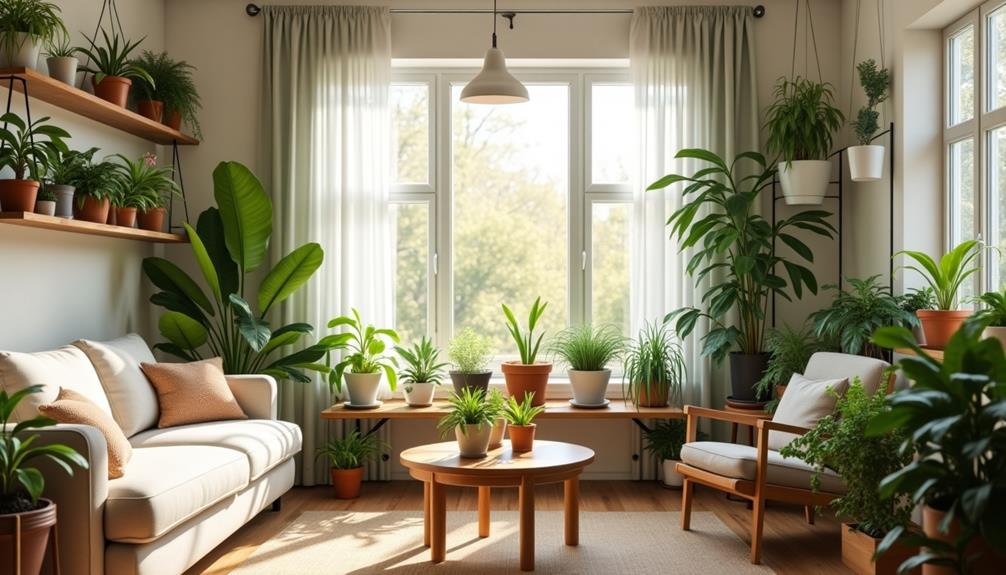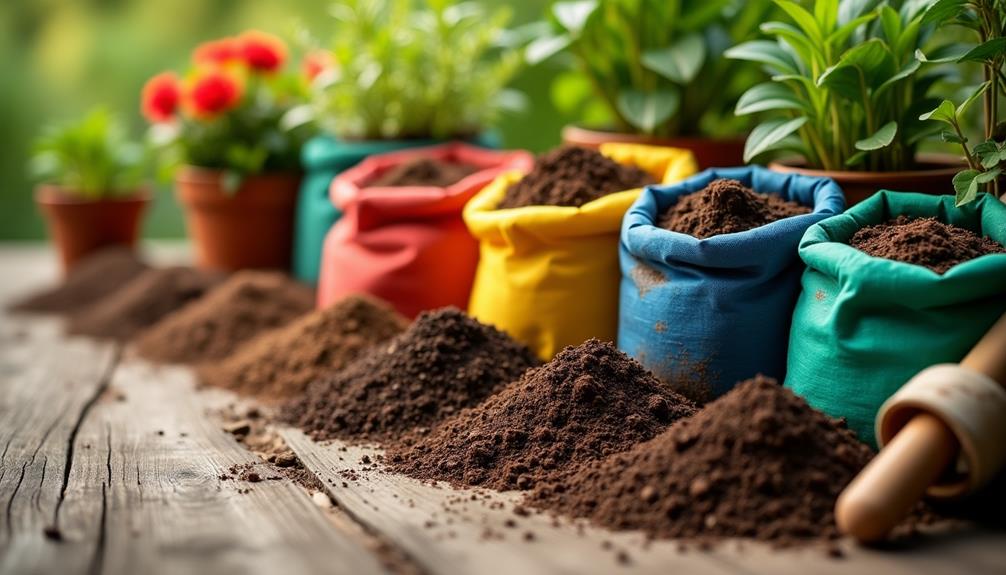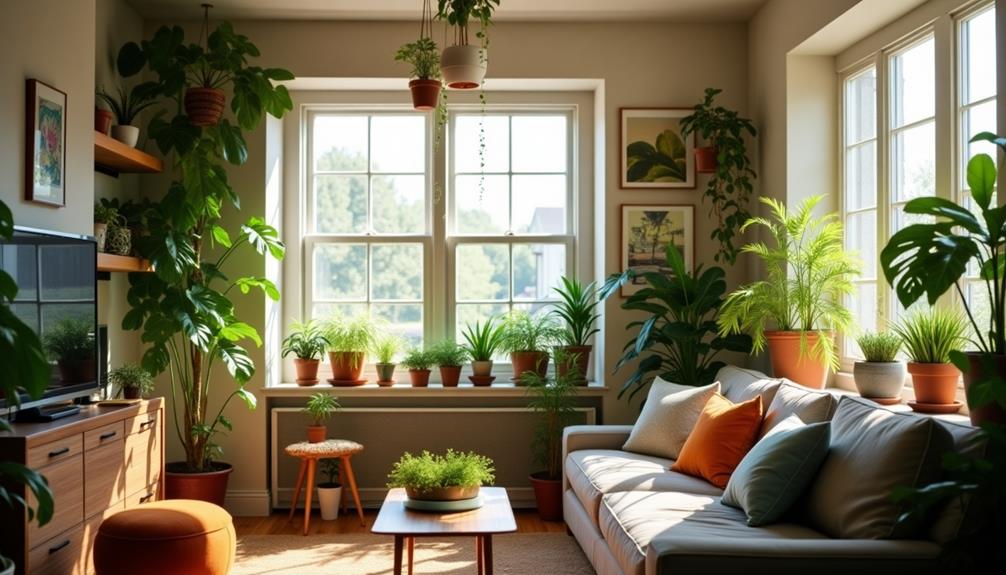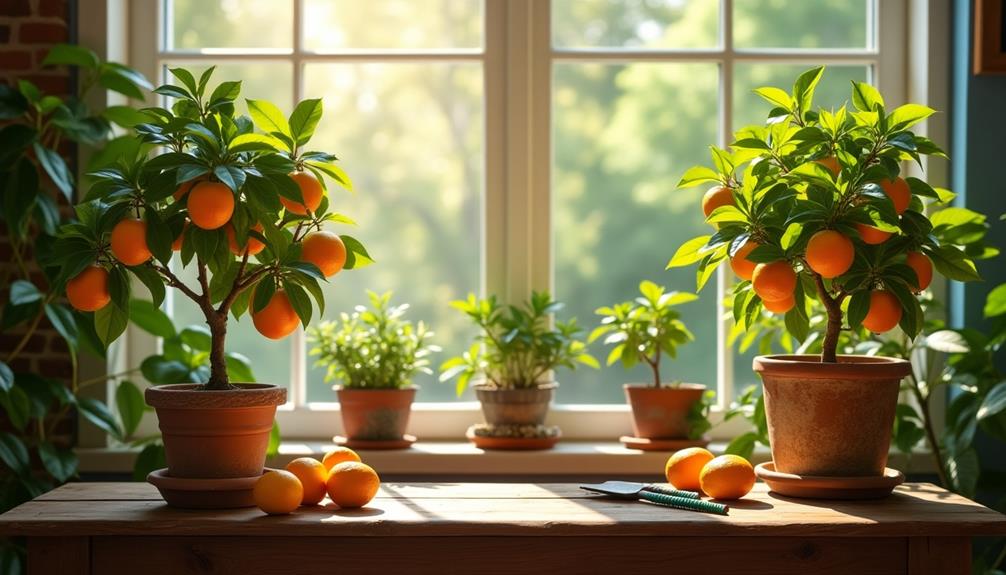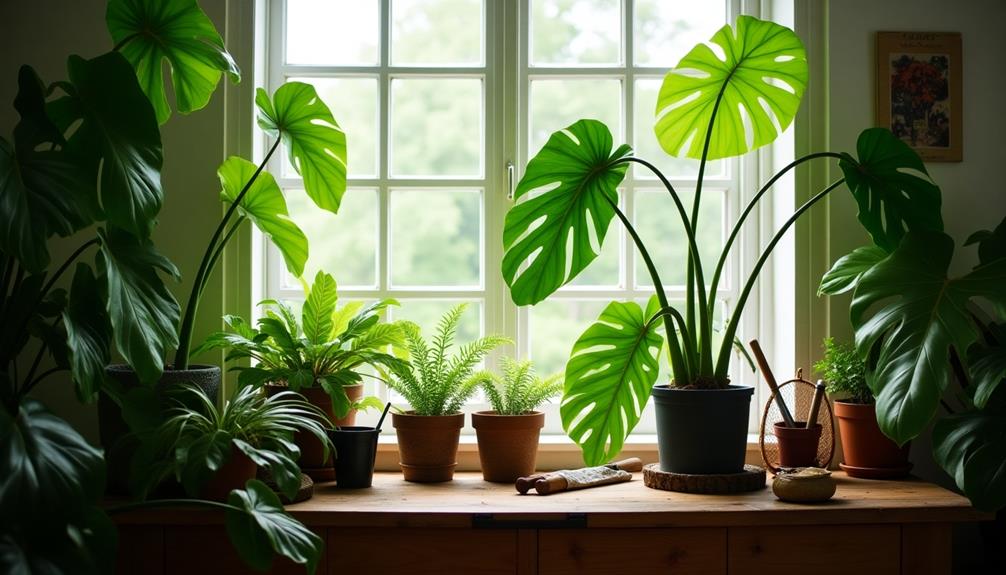When you think about styling plants in your home, it's important to consider how different varieties can complement your space while fitting your lifestyle. You'll want to select plants that thrive in your lighting conditions and choose pots that not only match your decor but also enhance it. Arranging them thoughtfully can create a cohesive look, but it's more than just placement. Understanding how to group plants effectively and use natural light can transform your environment. So, what are the key elements that can elevate your indoor plant game?
Choosing the Right Plants

When it comes to choosing the right plants for your home, consider your space, light conditions, and lifestyle.
Start by evaluating your available space—do you have large windows, or is your area more shaded? Certain plant types thrive in bright light, like succulents and cacti, while others, such as snake plants and pothos, do well in lower light.
Next, think about your lifestyle. If you travel frequently or tend to forget to water, opt for low-maintenance plants like ZZ plants or air plants that require minimal care.
Seasonal considerations also play a role; some plants may flourish during specific times of the year. For example, tropical plants often thrive in warmer months and might need special care in winter.
Moreover, consider how plant types can affect your home's air quality. Spider plants and peace lilies are great for purifying the air while adding a touch of greenery.
Selecting Stylish Pots
When it comes to selecting stylish pots, the materials and textures you choose can really elevate your plant display.
Think about how colors and patterns can either complement or contrast with your home decor.
Material and Texture Choices
Choosing the right materials and textures for your plant pots can dramatically enhance your home's aesthetic. Start by exploring different planter materials like ceramic, terracotta, and metal, each offering unique surface textures.
For a cozy, organic feel, consider pots with soft, fabric choices that blend seamlessly with your decor. Eco-friendly options, such as bamboo or recycled materials, not only look great but also support sustainable living.
Think about tactile contrasts when selecting your pots. A matte finish can be beautifully paired with a glossy decorative finish, creating visual interest.
You might also want to reflect seasonal themes through your choices; earthy tones for fall, vibrant colors for spring, and muted shades for winter can add a refreshing touch.
Don't shy away from organic shapes—curvy, asymmetrical pots can soften a space and draw the eye. It's all about combining functional styles with aesthetics.
For instance, choose deep planters for larger plants, ensuring they're both practical and stylish. By thoughtfully selecting materials and textures, you'll elevate your plants and overall interior design.
Color and Pattern Harmony
Selecting stylish pots that harmonize in color and pattern can transform your space and highlight your plants beautifully. To achieve this, consider color psychology—different colors evoke varying emotions. For instance, greens and blues create a calming atmosphere, while warm colors like red and orange can energize a room. Choose pots that reflect the mood you want to create.
When mixing patterns, be intentional. You don't want your pots to clash, so aim for a cohesive look. For example, if you have a geometric-patterned pot, pair it with a solid-colored one in a complementary hue. This technique enhances visual interest without overwhelming the space.
Don't shy away from playful combinations, either. A vibrant, patterned pot can make a striking statement while a minimalist design can ground your arrangement. Experiment with different shapes and sizes, too—varying heights add depth to your display.
Ultimately, the key is balance. Ensure your pots complement your plants without overshadowing them. With thoughtful selection, your plant display won't only thrive but also become a stunning focal point in your home.
Happy styling!
Finding Ideal Locations
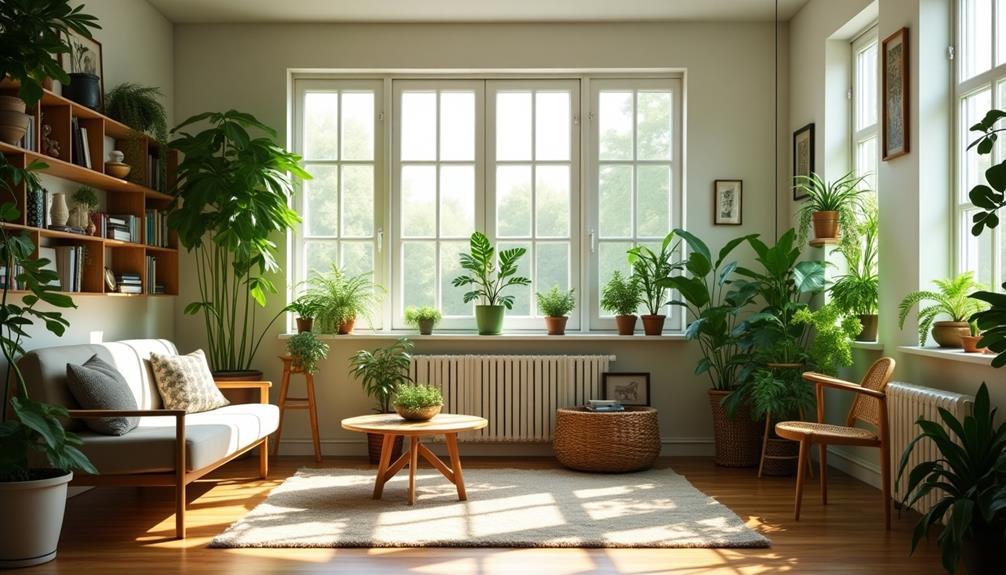
The joy of nurturing plants in your home begins with finding their ideal locations, as each plant thrives in different conditions.
Start by assessing the light conditions in each room. Some plants, like succulents and cacti, need bright, direct sunlight, while others, such as ferns and snake plants, prefer indirect light. Placing your plants in the right light can make all the difference in their health and growth.
Next, consider the room temperature. Most houseplants thrive in temperatures ranging from 65°F to 75°F (18°C to 24°C). Avoid placing them near drafts, heaters, or air conditioning units, as extreme temperature fluctuations can stress them.
Pay attention to how the sunlight shifts throughout the day, as this will affect your plants' light exposure.
Use your windowsills, shelves, and corners wisely—each space offers unique opportunities. Observe your plants regularly to see how they respond to their environments. If a plant looks droopy or discolored, it might be a sign it needs a new spot.
Grouping Plants Together
Grouping plants together can create a stunning visual impact while providing benefits for their growth. When you arrange plants in combinations, you not only enhance your space but also foster a thriving environment. Plants can share humidity, which helps them stay healthy and vibrant.
To achieve visual balance, consider mixing different leaf shapes, colors, and textures. For instance, pair a tall, spiky plant with a low, lush one to create contrast. Use pots in similar colors or materials to unify the arrangement, making the plants the focal point without overwhelming the space.
Additionally, think about the light requirements of your selected plant combinations. Grouping plants with similar needs ensures they thrive together. This method also simplifies your care routine, as you'll know when to water and fertilize your grouped plants.
Incorporating Different Heights
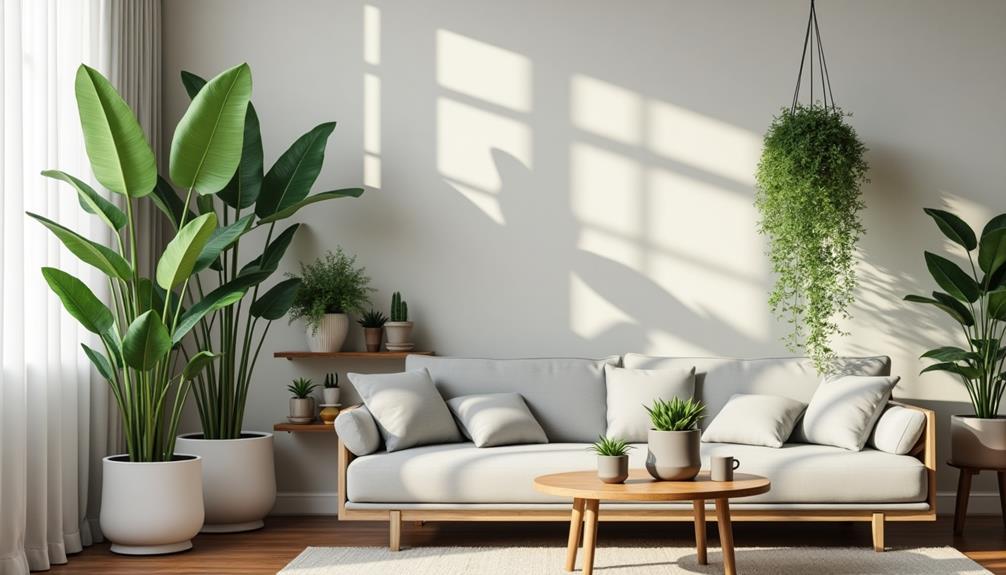
To create a dynamic and visually appealing plant arrangement, you'll want to incorporate different heights.
Consider using varying plant stand heights, hanging planters, and layered shelf arrangements to add depth to your space.
This approach not only enhances the aesthetic but also allows each plant to shine in its own way.
Vary Plant Stand Heights
Incorporating a variety of plant stand heights can transform your space, adding depth and visual interest. By mixing different plant stand styles, you create an engaging focal point that draws the eye around the room.
Start by assessing your plants' sizes and shapes, then choose stands that complement them while varying the heights. For a dynamic look, consider using a tall plant stand for a floor plant alongside shorter stands for smaller pots. This height variation not only highlights each plant but also creates a layered effect that's visually appealing.
You might also want to group plants of similar heights on a single stand to maintain balance while still enjoying the overall contrast.
Don't shy away from experimenting with unique materials and designs for your plant stands. A modern metal stand can juxtapose beautifully against a rustic wooden one, enhancing the overall aesthetic of your space.
Use Hanging Planters
Hanging planters are a fantastic way to add vertical interest to your space, especially when combined with varied heights. By incorporating different hanging techniques, you can create a dynamic look that draws the eye upward and enhances your indoor aesthetics.
Start by selecting a mix of planters in various sizes and shapes. Consider using macramé hangers for a bohemian vibe or sleek metal hooks for a modern touch. Hang smaller planters higher up, like near the ceiling, while positioning larger ones at eye level or slightly below.
This layering not only creates visual depth but also makes your plants a focal point in the room. Don't hesitate to play with textures and colors as well. For instance, a vibrant trailing plant like a pothos can look stunning cascading down from a high perch, while a bold, leafy plant can command attention when suspended at mid-height.
Remember to keep your space balanced; if you have a tall plant on one side, consider mirroring it with another hanger on the opposite side. This thoughtful arrangement ensures your indoor aesthetics remain cohesive and inviting while maximizing your plant display.
Layered Shelf Arrangements
A well-styled shelf can transform your space, and layering plants at different heights is key to achieving that eye-catching effect. Start by considering your shelf spacing; you want to utilize the vertical space effectively.
Mix small, medium, and tall plants to create a dynamic arrangement. Place the tallest plants at the back or center, so they don't overshadow the smaller ones in front.
To achieve visual balance, think about the colors and textures of the plants. Group plants with similar hues or contrasting foliage together to create harmony. For example, pair a tall snake plant with cascading pothos on the same shelf.
If you're using decorative pots, vary their heights to add depth and interest.
Don't forget about the surrounding decor! Incorporate books or decorative objects to break up the greenery and provide additional layers. This approach not only enhances the shelf's aesthetic but also keeps it from feeling cluttered.
Using Natural Light Effectively
Maximizing natural light is essential for keeping your plants healthy and vibrant. To achieve this, you'll need to consider both light direction and light intensity.
Start by observing how sunlight enters your home throughout the day. South-facing windows usually provide the strongest light, while north-facing windows offer softer illumination. Based on these observations, you can position your plants to soak up the most beneficial rays.
Next, pay attention to the light intensity. Different plants require varying levels of brightness. For instance, succulents and cacti thrive in bright, direct sunlight, while ferns and snake plants prefer indirect light.
If you find that a particular area of your home receives too much sunlight, use sheer curtains to diffuse the light. Conversely, if a space seems too dim, consider moving your plants closer to the window or using reflective surfaces to help amplify light.
Rotate your plants periodically to ensure all sides receive equal exposure. This simple step prevents uneven growth and keeps your plants looking lush and balanced.
Adding Decorative Accessories
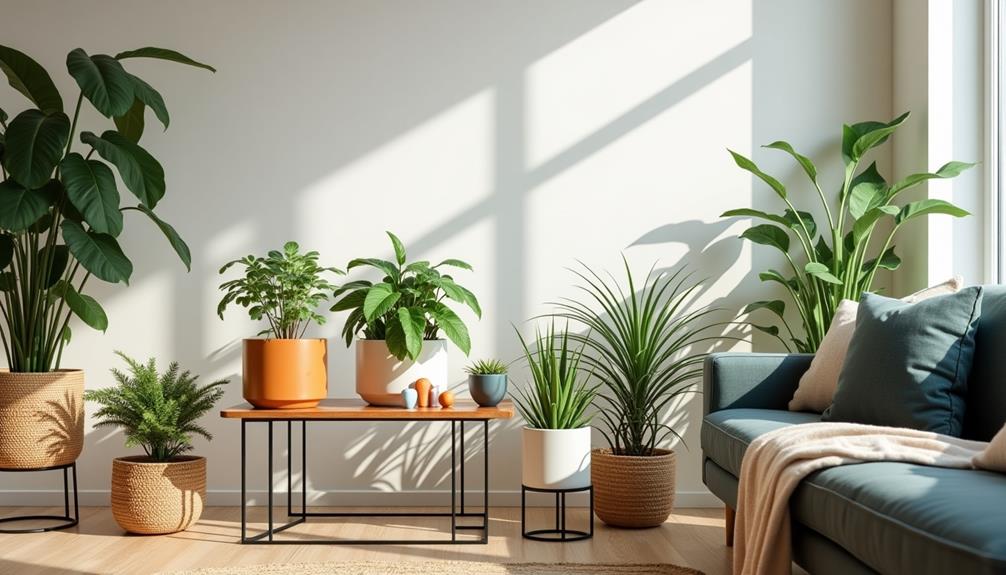
Decorative accessories can transform your plant display from ordinary to extraordinary. By adding the right plant accessories, you can enhance your space and showcase your botanical treasures.
Start by incorporating decorative elements that reflect your personal style. Whether you prefer minimalist simplicity or themed decor, there's a plethora of options to choose from.
Consider using seasonal accents to keep your display fresh and engaging. For instance, during autumn, you might add small pumpkins or colorful leaves, while spring could call for pastel pots or floral motifs.
Artistic arrangements can elevate your plants' visual appeal—try grouping different heights and textures to create dynamic displays.
Don't forget about functional decor; items like stylish watering cans or plant stands can serve a purpose while looking great. You can also incorporate botanical art to tie your theme together.
Look for pieces that add color pops or textural contrasts, enhancing the overall aesthetic. Lastly, embrace seasonal themes to keep your decor lively and relevant.
With these tips, you'll create a captivating environment that highlights your plants and reflects your unique style.
Maintaining Plant Health
To keep your plants thriving, regular maintenance is key. Start by mastering your watering techniques. Overwatering is a common mistake that can lead to root rot, while underwatering can cause stress and wilting.
Check the soil moisture level before watering; sticking your finger an inch into the soil can help you determine if it's time for a drink. Different plants have different needs, so be sure to research each one's specific requirements.
Next, implement effective pest control strategies. Keep an eye out for common pests like spider mites, aphids, and mealybugs. Regularly inspect your plants, especially the undersides of leaves, where these pests tend to hide.
If you spot any unwanted guests, act quickly. You can often remove them by hand or use a gentle insecticidal soap.
Additionally, maintaining proper humidity and temperature levels is crucial for plant health. Many houseplants thrive in higher humidity, so consider misting them or placing a humidifier nearby.

